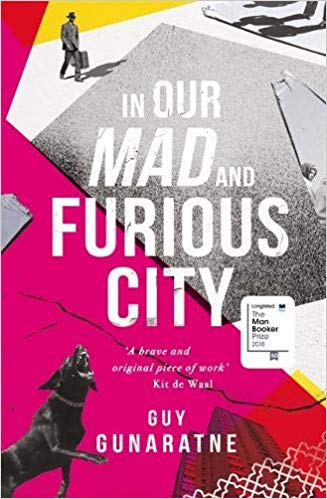In the run up to the announcement of the winner of this year’s International Dylan Thomas Prize, Wales Arts Review will be publishing reviews of the six shortlisted titles, written by the students of the IDT Prize module at Swansea University. We begin with a review of Guy Gunaratne’s novel In Our Mad and Furious City (Tinder Press) by Amy Jones.
The module is the first English academic study in the world dedicated to a major literally prize and includes access for the students to authors and members of the publishing industry who run tutorials on subjects ranging from book marketing and publicity, to book prize logistics and sales in publishing to help students to explore how literary prizes help to produce, promote and celebrate contemporary writing.
 Language, grime and community make up the lifeblood of the Stones Estate. Hunted and threatened by old and new violent forces; five characters must find their way in a mad and furious city.
Language, grime and community make up the lifeblood of the Stones Estate. Hunted and threatened by old and new violent forces; five characters must find their way in a mad and furious city.
Guy Gunaratne’s debut novel holds a mirror to London, building a city infused with anxiety as each character tries to find a way out of the Ends. The events unfold over the course of 48 hours and focuses on the stories and lives of three young men – Selvon, Ardan and Yusuf – whose friendships stand as strong as the Estate tower blocks they call home. The reader learns quickly how fragile and important community can be when something destroys the wavering balance. After the ruthless murder of an off-duty soldier by a black man (an echo of the 2013 murder of Lee Rigby) the Estate descends into riot and radicalism. This breakdown of community pulls the boys in very different directions, shedding light on how difficult it can be to find opportunities to escape.
Gunaratne’s London is a familiar stranger. In Our Mad and Furious City begins with Selvon on a morning run through the Estate, the four oppressive tower blocks sets an uncanny resemblance to London. It is so well detailed you cannot help but feel you have stood in the same place the three boys meet to play football. It becomes apparent as you continue reading that Selvon is also acting as a metaphor for all those who are running from their lives.
The novel dances with truth and reality throughout as Gunaratne leaves biographical traces. His connection with the Stones Estate, having grown up in a similar area, is strong in each of the separate narratives. His use of language also reveals just how connected he is to the real spaces of the city. From the start the reader is instantly immersed in world of sound and rhythm. The boy’s roadman dialect drops from their lips smoothly with the well-known “ennet” and “wa-gwan” running through the novel like a chorus or refrain. Gunaratne transitions masterfully between the voices of the young boys and the two older characters, Caroline and Nelson. Caroline, Ardan’s mother (who moved from Ireland to get away from her family’s involvement in the IRA) contrasts the boy’s colloquiums with her Irish twang. For Nelson, Selvon’s now mute father, who moved to London from the small Caribbean island Montserrat for work his interior voice maintains a strong West Indian accent. Gunaratne has layered five unique voices that come together and give readers an insight into the diverse cultures of the city. The melodic and poetic nature of the novel is complimented with references to grime, music grown from the youth of London’s East End. Gunaratne uses the language of his youth to create voices that are honest and harmonious.
In Our Mad and Furious City is a novel that balances ideas of monstrosity and humanity in its exploration of the boy who killed the soldier. Gunaratne humanises him and, in part, Michael Adebolajo (Lee Rigby’s killer). It is apparent that this is not to produce sympathy but to illustrate how calling people monsters detaches them from their vile crimes. Caroline and her experiences with the IRA become shocking because it is contrasted with her domesticity. It is this normality that becomes a focus in the book. Similarly, Yusuf notices that the black boy who killed the soldier “looked as if he had just rolled out the same school gates”. For Gunaratne it’s not the killing that is shocking but that someone who looked so normal could commit such violence. Gunaratne’s is trying to confront a paradox, he states that: “seeking to confront violent pathologies doesn’t excuse or diminish monstrous acts. It confronts the ugliest side of ourselves so that we may do something about it.” Confronting these ideas is exactly what he has done with this important and revealing novel.
You can also listen to Guy Gunaratne’s podcast interview with Swansea University students here, where he talks about In Our Mad and Furious City and much more.










